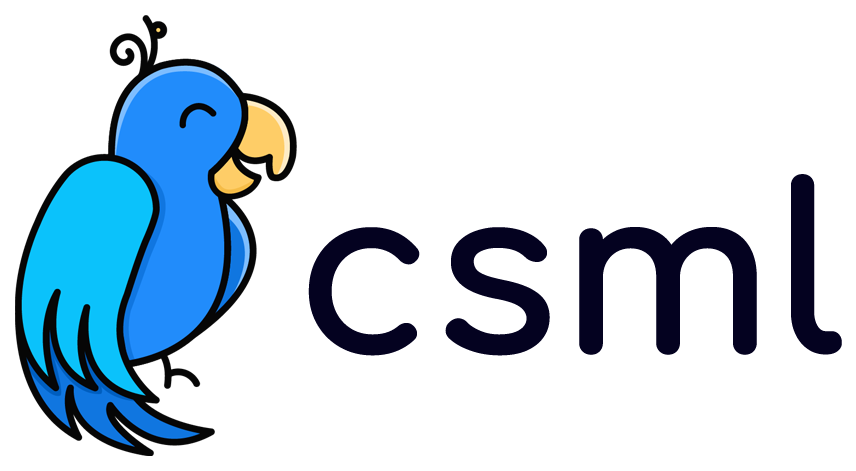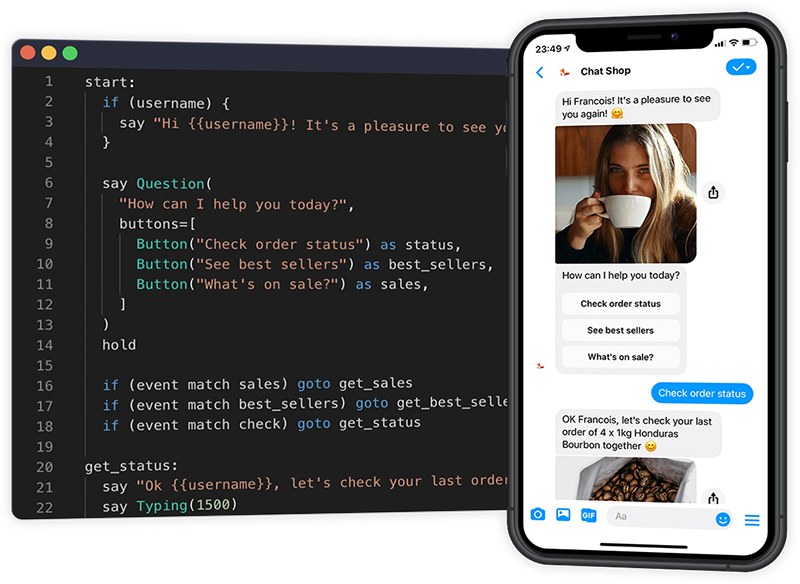Key Features • Example • Getting started • Additional Information
CSML (Conversational Standard Meta Language) is both a domain-specific programming language and chatbot engine, designed to make it easy to develop complex chatbots.
With a very expressive and text-only syntax, CSML flows are easy to understand, making it easy to deploy and maintain conversational agents. CSML handles short and long-term memory slots, metadata injection, and connecting to any third party API or injecting arbitrary code in any programming language thanks to its powerful runtime APIs.
- Text-only, expressive syntax, easy to learn and develop complex chatbot scenarios with
- Rich and extensible conversational components such as Carousel, Image, Video, Button, Card, Input, Calendar...
- Built-in short-term and long-term memory slots: no more complex state machine boilerplate
- Portable, fast, and easy to deploy: it only requires a standard MongoDB, PostgreSQL or SQLite database
- Vibrant community of over 20,000 active CSML developers
start:
say "Hi, nice to meet you, I'm a demo bot 👋"
if (name) {
say "I already know you 😉"
goto known
}
else
goto name
name:
say Question(
"I'd like to know you better, what's your name?",
buttons=[
Button("I'm anonymous 😎", accepts=["No", "Nope"]) as anonBtn
],
)
hold
if (event.match(anonBtn)) {
remember name = "anon"
} else {
remember name = event
}
goto known
known:
if (name == "anon")
say "...but I know you don't want to say too much about yourself!"
else
say "You are {{name}}!"
goto endThe full documentation is available on https://docs.csml.dev/language.
The simplest way to get started with CSML is to use CSML Studio, a free online development environment with everything already setup to start creating bots right away, directly in your browser.
To get started with CSML Studio: https://studio.csml.dev
CSML Studio gives you a free playground to experiment with the language as well as options to deploy your chatbots at scale in one-click.
CSML is available as a self-hostable web server that you can easily install with one of the options below.
Note that you will need a database. The default choice is MongoDB, but Amazon DynamoDB, PostgreSQL and SQLite
are also available by choosing the mongodb, dynamodb, postgresql or sqlite engine DB type with a slightly different set of environment variables.
Before you start, make sure that you have the environment set with following options:
ENGINE_DB_TYPE=mongodb # must be one of mongodb|dynamodb|postgresql|sqlite
# for mongodb
MONGODB_URI=mongodb://username:password@localhost:27017
MONGODB_DATABASE=csml
# for postgresql
POSTGRESQL_URL=postgres://user:password@hostname:port/database
# for sqlite
SQLITE_URL=csml.db
# for dynamodb (requires S3 for storage of large items)
AWS_ACCESS_KEY_ID= # or use a local IAM role
AWS_SECRET_ACCESS_KEY= # or use a local IAM role
AWS_REGION=
AWS_DYNAMODB_ENDPOINT= # optional, defaults to the dynamodb endpoint for the given region.
AWS_DYNAMODB_TABLE=
AWS_S3_ENDPOINT= # optional, defaults to the S3 endpoint for the given region
AWS_S3_BUCKET=
# CSML Server configuration
ENGINE_SERVER_PORT=5000
ENGINE_SERVER_API_KEYS=someAuthKey4CsmlServer,someOtherAuthKey
# Other optional engine configuration
ENGINE_ENCRYPTION_SECRET=some-secret-string # if not set, data will not be stored encrypted
TTL_DURATION=30 # auto-remove chatbot user data after X days
LOW_DATA_MODE=true # do not store contents of sent/received messages
DISABLE_SSL_VERIFY=false # reach trusted endpoints with known invalid certificates
DEBUG=true # print debug output in console
CSML_LOG_LEVEL=error # print log output in stderr. Possible values are error, warn, info, debug, trace.
MODULES_URL= # default module repository base url
MODULES_AUTH= # default module auth token
The easiest way to launch a CSML Engine on your own machine is to use one of our pre-built, optimized binaries (available for both MongoDB and Amazon DynamoDB). These binaries are available as executables on each of CSML's releases since v1.3.0.
Follow the installation guide (for ubuntu, but the process will be similar on other operating systems) along on this blog post: https://blog.csml.dev/how-to-install-a-self-hosted-csml-engine-on-ubuntu-18-04/
To download the latest CSML Server binaries, head over to the latest release and make sure to download the right version for your architecture.
Mac users: upon first execution of this binary, Mac will probably open a warning about the application not being signed (more info from Apple). As this is not intended as a widely-distributed application, we decided to not go through the notarization process for now, but you can safely ignore that warning! However, if you prefer, you can always build this package from source.
We provide a docker image for easy self-hosted usage.
docker pull clevy/csml-engine
To get started with CSML Engine on Docker: https://github.com/CSML-by-Clevy/csml-engine-docker
CSML is built in Rust. You don't need to know any Rust to run it though! Make sure you are running Rust v1.46+ and that you have openssl installed on your machine (or an equivalent for your linux distribution, such as libssl), then run:
cd csml_server
# for use with MongoDB
cargo build --release --features csml_engine/mongo
# for use with Amazon DynamoDB
cargo build --release --features csml_engine/dynamo
After that, execute your build (by default under ./targets/release/csml_server) and visit http://localhost:5000 for some request examples.
This repository provides Node.js bindings of this rust library. To use this library in a Node.js project, you will need to build it from source. There are a few requirements:
- Current Rust Stable version (v1.61.0 and above)
- Node.js LTS
- cargo-cp-artifact v0.1.6 required dependencies
- libssl-dev (or equivalent for your architecture: openssl-dev, libssl-devel...)
To compile CSML Engine into a native node module, run:
git clone https://github.com/CSML-by-Clevy/csml-engine csml
cd csml/bindings/node/native
npm run build -- --releaseNB: you can build specifically for MongoDB, DynamoDB, SQLite or PostgreSQL by using one of the specialized scripts (i.e
npm run build:mongodb) in the package.json.
This method will output this native file: csml/bindings/node/native/index.node that you can simply require() (or import) in your project. For more details about how to use this module in your own projects, you can have a look at our implementation for Docker version.
Please note that if you plan to deploy your project on a different architecture, you will need to recompile the project on that architecture. We recommend using git submodules if you need to integrate CSML Engine in your own Node.js projects.
CSML Server's HTTP REST API documentation is available in OpenAPIv3 format: swagger.yaml. To read this file easily, you can open it in Swagger Editor.
- Studio - Create and deploy your chatbot in a matter of minutes.
- Playground - Test and learn CSML in your browser.
- Slack - The official CSML community.
- CSML Documentation - Getting started.
- Release notes - Stay up to date.




